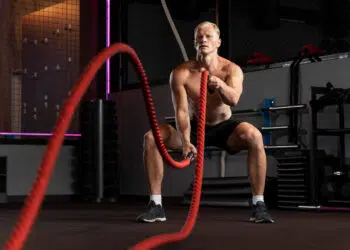Do you need a new workout that’ll take your gains to the next level? Then I’m here to help. This workout is for serious bodybuilders looking to train hard and often and maximize their gains.
I’ve been working in the fitness industry for over 30 years. During that time, I’ve written thousands of workouts. Hardly a week goes by without a client or acquaintance reaching out for a new program.
While I personally prefer full-body workouts, I recognize the value of split routines, especially for bodybuilders.
Research shows that hypertrophy, or increases in muscle size, is the result of several factors (1). These include:
- Muscle tension
- Metabolic stress
- Muscle damage
- Hormonal changes
- Adequate nutrition
- Rest/recovery/sleep
In many cases, the most practical way to maximize all these factors is with a split routine. This means training different muscle groups or body parts on different days.
There are dozens of ways to design a split routine. Popular split routine options include upper body/lower body, push/pull/legs, body part splits, and movement pattern splits. While each one invariably has fans and detractors, the truth is that they all work. Consequently, it all comes down to finding the routine that best suits your needs and goals.
Level Up Your Fitness: Join our 💪 strong community in Fitness Volt Newsletter. Get daily inspiration, expert-backed workouts, nutrition tips, the latest in strength sports, and the support you need to reach your goals. Subscribe for free!
In this article, I’m going to share an advanced split routine for serious bodybuilders. Although, be warned: this program is not for the faint-hearted. But, if you’ve been training for a few years, this split routine will take your gains to the next level.
Are You Ready for This Training Routine?
This program is tough, with a capital T! It’s not suitable for beginners, and there are other exercisers who should avoid it and choose something else. Therefore, consider the following criteria before starting this plan.
Experience Level
There are no official definitions for beginner, intermediate, and advanced bodybuilders. However, for the purpose of this article, I’ll define them as:
- Beginner: Less than one year of training.
- Intermediate: One to two years of training.
- Advanced: Three or more years of training.
Accordingly, only attempt this routine if you are a late-stage intermediate or advanced bodybuilder. If you are new to bodybuilding, this is not the training plan for you. As a beginner, you probably don’t have the tolerance for such frequent or intense workouts. Build your fitness foundation with a more basic plan before progressing to this one.
Training Consistency
Are you coming off a lengthy training break? Have you missed more workouts than you’ve completed lately? If so, you probably aren’t ready for this workout plan. Experience counts for nothing if you are out of practice. Therefor, you should make sure you’ve got a few months of unbroken training under your belt before attempting this program.
Health and Injury Status
This is not a workout plan for injured bodybuilders or exercisers with underlying health issues. If we were face to face, I’d ask you about your health and injury status and tell you whether this workout plan was right for you. This is called a medical screening and one of the most critical duties of a personal trainer.
Needless to say, this is impossible, so you’ll need to screen yourself to determine if this workout is right for you. If you have current joint or muscle injuries, have recently been ill, or have an underlying medical condition, you should probably avoid this program.
Dietary Habits
How’s your diet? Do you eat healthily, consuming adequate protein and plenty of whole foods? Or is your idea of a balanced diet hamburgers one day and pizza the next? All washed down with gallons of Coke!
Intense training takes a lot out of your body, and you’ll need to feed and hydrate your muscles for them to recover and grow. You’ll also need a calorie surplus to fuel your workouts and muscle growth; this is not a cutting program.
In other words, get your diet on point and keep it there to ensure your body has all the nutrients it needs. You are what you eat, so if your diet is mostly junk, your progress will be too.
Sleep and Recovery
Just like food affects your bodybuilding success, so does getting enough rest and sleep. After all, your body does most of its recovery and growth between workouts. Ensure you get 7-9 hours of sleep per night – weekdays and not just weekends. Minimize extracurricular physical activity and save your energy for training and recovery.
That doesn’t mean you should be sedentary between workouts. However, you should avoid doing excessive cardio, playing sports, and otherwise tiring yourself out.
Training Goal
This is not a fat-loss or fitness program. Instead, it’s a bodybuilding routine for maximizing hypertrophy or muscle growth. If that’s not your training goal, you should look for another program.
Because of the principle of specificity, your body adapts to the type of workouts you do most often. Consequently, this program is only suitable for bodybuilders and those who want hypertrophy, e.g., athletes looking to gain mass.
Age
At the risk of being ageist, I respectfully suggest that this program is probably unsuitable for older exercises. As a person in their 50s, I know that things like joint health and recovery abilities decrease with each passing decade.
On the other hand, there are some seemingly ageless exercisers who can keep on pushing hard well into their 60s and beyond. However, these people are the exceptions rather than the norm.
If you are an older exerciser who wants to try this routine, please reduce the training volume and listen to your body. Starting to get aches and pains or feel unrecovered between workouts? Then you should quit this program and move on to one that’s more forgiving.
Warming Up for A Great Workout
Every great workout starts with a thorough warm-up. Warming up prepares your joints, muscles, and nervous system for what you’re about to do. It enhances your performance, making your workout more effective. Warming up may also lower your risk of injury.
But how do you warm up for an intense bodybuilding workout? It’s actually not that complicated!
There are several stages to an effective warm-up. These are:
Pulse Raiser
This is the part of the warm-up that gets you warm. It generally involves doing 5-10 minutes of light cardio. The pulse raiser elevates your heart and breathing rate and gets your blood pumping. Take care not to turn this warm-up component into a cardio workout. After all, your primary focus is building muscle, not burning calories.
Joint Mobility
Your joints are going to take a metaphorical hammering during these workouts. Joint mobility exercises increase synovial fluid production. This is what your body uses to lubricate your knees, hips, shoulders, etc. Joint mobility exercises include shallow squats and lunges, shoulder shrugs, and arm circles.
Dynamic Flexibility
Static stretches, e.g., touching your toes for 30-60 seconds, are an effective way to increase flexibility. However, they may also reduce muscle contractility, reducing force production (2). While such effects are minimal, it’s generally best to prepare your muscles for strength training with dynamic stretches.
Dynamic stretches include leg swings, deep bodyweight lunges and squats, standing pec flyes, and other large-range movements. Focus on the muscles you are about to work. There is no need to spend time on your lower body if you’re preparing to train your chest.
Ramped Sets
The last part of your warm-up will ease the transition from being sedentary to intense training. This phase primes your muscles and nervous system with a few progressively heavier sets of your first exercises.
Level Up Your Fitness: Join our 💪 strong community in Fitness Volt Newsletter. Get daily inspiration, expert-backed workouts, nutrition tips, the latest in strength sports, and the support you need to reach your goals. Subscribe for free!
For example, on chest day, when you plan on doing sets of 220 pounds for the bench pressing, your ramped sets might look like this:
- 10 reps @ 45 pounds (empty barbell)
- 7 reps @ 110 pounds
- 5 reps @ 155 pounds
- 3 reps @ 185 pounds
- 10 reps @ 220 pounds (1st work set)
Note how the reps decrease as the weight increases. This ensures that you warm up without wearing yourself out. You won’t need to use ramped sets for all the exercises. However, you should use them if you switch movement patterns. For example, for your first chest exercise and then your first back exercise.
Read more about warming up for strength training here.
Warmed up and ready to go? Then let’s get to work! In the next section, I reveal my advanced workout for serious bodybuilders.
Advanced Training Routine for Serious Bodybuilders
So, at last, here’s your advanced bodybuilding routine for serious bodybuilders! It involves six workouts and hits each major muscle group twice per week. This provides a great balance between training and recovery. It also lets you hit each muscle group with the intensity and volume necessary for optimal growth.
Here is an overview of your training week:
| Days | Workout |
| Monday | Back & Biceps |
| Tuesday | Chest & Triceps |
| Wednesday | Legs – Hamstring Focus + Abs |
| Thursday | Shoulders & arms |
| Friday | Legs – Quadriceps Focus + Abs |
| Saturday | Chest & Back |
| Sunday | Rest |
Workout 1: Back & Biceps
| # | Exercise | Sets | Reps | Recovery |
| 1 | Rack pull | 4 | 4-6 | 3 minutes |
| 2 | Pull-up | 3 | 8-10 | 90 seconds |
| 3 | Single-arm row | 3 | 8-10 | 90 seconds |
| 4 | Lat pulldown | 3* | 12-15 | 60 seconds |
| 5 | Preacher curl | 2 | 8-10 | 90 seconds |
| 6 | Hammer curl | 2 | 8-10 | 90 seconds |
| 7 | Cable curl | 2* | 12-15 | 60 seconds |
* Perform a double drop-set (two weight reductions) on your last set.
Workout 2: Chest & Triceps
| # | Exercise | Sets | Reps | Recovery |
| 1 | Bench press | 4 | 4-6 | 3 minutes |
| 2 | Incline DB press | 3 | 8-10 | 90 seconds |
| 3 | Dip | 3 | 8-10 | 90 seconds |
| 4 | Cable crossover | 3* | 12-15 | 60 seconds |
| 5 | Skull crusher | 2 | 8-10 | 90 seconds |
| 6 | Overhead triceps extension | 2 | 8-10 | 90 seconds |
| 7 | Triceps pushdown | 2* | 12-15 | 60 seconds |
* Perform a double drop-set (two weight reductions) on your last set.
Workout 3: Legs/Hamstrings Focus + Abs
| # | Exercise | Sets | Reps | Recovery |
| 1 | Romanian deadlift | 4 | 4-6 | 3 minutes |
| 2 | Seated leg curl | 3* | 8-10 | 90 seconds |
| 3 | Barbell hip thrust | 3 | 12-15 | 60 seconds |
| 4 | Standing calf raise | 4 | 8-10 | 90 seconds |
| 5 | Kneeling cable crunch | 3 | 12-15 | 60 seconds |
| 6 | Reverse crunch | 3 | 12-15 | 60 seconds |
* Perform a double drop-set (two weight reductions) on your last set.
Workout 4: Shoulders & Arms
| # | Exercise | Sets | Reps | Recovery |
| 1 | Military press | 4 | 4-6 | 3 minutes |
| 2 | Upright row | 3 | 8-10 | 90 seconds |
| 3 | Cable lateral raise | 3 | 12-15* | 60 seconds |
| 4 | Barbell curl | 2 | 8-10 | 60 seconds |
| 5 | Diamond push-up | 2 | AMRAP | 60 seconds |
| 6 | Dumbbell curl | 2 | 8-10 | 90 seconds |
| 7 | Triceps kickback | 2 | 12-15 | 60 seconds |
* Perform a double drop-set (two weight reductions) on your last set.
AMRAP = As Many Reps as Possible. Continue until failure, rest, and repeat!
Workout 5: Legs/Quadriceps Focus
| # | Exercise | Sets | Reps | Recovery |
| 1 | Front squat | 4 | 4-6 | 3 minutes |
| 2 | Leg extension | 3* | 8-10 | 90 seconds |
| 3 | Hack squat | 3 | 12-15 | 60 seconds |
| 4 | Seated calf raise | 4 | 8-10 | 90 seconds |
| 5 | Cable woodchop | 3 | 12-15 | 60 seconds |
| 6 | Hanging knee raise | 3 | 12-15 | 60 seconds |
* Perform a double drop-set (two weight reductions) on your last set.
Workout 6: Chest & Back
| # | Exercise | Sets | Reps | Recovery |
| 1a | Incline barbell bench press | 4 | 4-6 | 3 minutes |
| 1b | Yates row | |||
| 2a | Dumbbell bench press | 3 | 8-10 | 90 seconds |
| 2b | Chin-up | |||
| 3a | Pullover | 2 | 12-15 | 60 seconds |
| 3b | Pec deck |
Perform the exercises in this workout as supersets. Do exercise 1a immediately followed by 1b. Rest for three minutes, and then repeat the pairing. Do four supersets, then move on to the next two exercises – 2a/2b. Use the same approach for 3a/3b.
Advanced Split – FAQ’s
Do you have a question about my advanced split routine for serious bodybuilders? No problem, because I’ve got the answers! Need more information? Feel free to drop me a line in the comments section below, and I’ll get back to you ASAP.
1. What weights should I use for this workout?
Use a weight that brings you close to failure at the lower end of the specified rep range. For instance, if the program calls for 8-10, pick a weight with which you can just do eight.
Then, as the weeks pass and you get stronger, work hard to get more reps per set. When you can do all your sets at the higher end of the rep range, increase the load by 10% and start over.
For example:
- 1st week: 4/4/4 reps with 200 pounds
- 2nd week: 5/5/4 reps with 200 pounds
- 3rd week: 6/5/5 reps with 200 pounds
- 4th week: 6/6/6 reps with 200 pounds
- 5th week: 4/4/4 with 220 pounds, etc.
2. Can I change some of the exercises?
I’ve chosen these exercises based on my 30+ years of training experience. Ultimately, they’re movements that I believe are amongst the best for bodybuilding. Nevertheless, I also understand that you may have different exercise preferences. There might be movements that you cannot do or do not enjoy.
Therefore, feel free to make changes as necessary. However, please stay true to the spirit of the program. In other words, if you make any changes, ensure you use similar exercises. For instance, swapping barbell for dumbbell bench presses is fine. In contrast, doing dumbbell flys instead of bench presses is not, as they’re too dissimilar.
3. What should I do if I can pump out more than 8-10 pull-ups, chin-ups, and dips?
When it comes to bodyweight exercises, most people focus on doing more reps. While this is an effective progression method, it’s not the best way to build muscle.
So, for this workout, I want you to add resistance by using a weighted vest or hanging a dumbbell around your waist. That way, you can use the same progression method outlined in question one. This will keep those gains coming, without resorting to progressively higher reps.
4. What should I do if I miss a workout?
Training six times a week is a big commitment. So, firstly, make sure you have the time to hit the gym according to the schedule provided. Don’t even start this routine if you have doubts about completing the prescribed workouts.
Of course, life has a way of derailing even our best intentions, and missing the occasional workout is sometimes unavoidable. This leaves you with a couple of choices:
- Catch up on the missed workout on Sunday.
- Workout twice in one day to make up for the missed workout.
- Skip it, and don’t worry about it.
If you regularly miss workouts, this plan may not be for you. Moreover, I recommend adopting a less frequent training plan, such as a four-day program.
5. Do you have any suggestions for how to turn this into a five-day plan?
If you really want to do this program but can only commit to five weekly training sessions, I suggest dropping Saturday’s chest and back workout. You should still make good progress because you’ll be training both muscle groups earlier in the week.
You may be tempted to amalgamate the two leg workouts, but I don’t recommend it. That’s because your lower body makes up about 40% of your total muscle mass. Reducing leg training frequency to just once a week means you will train your upper body far more than your lower body. As a result, this could compromise your gains.
6. What supplements do you recommend for this training routine?
You can build muscle and get stronger without supplements. On the other hand, there are several products that may enhance your gains. These include:
- Creatine for increased energy and strength and faster recovery.
- Pre-workout for a better pump and instant energy boost.
- BCAAs and EAAs to enhance recovery.
- Melatonin and ZMA for longer, deeper sleep.
- Weight gainers to ensure you’re consuming enough calories.
- Whey protein powder to make it easier to consume enough of what your muscles need to recover and grow.
None of these substances compensate for a poor diet or inconsistent training. Nevertheless, they may provide you with a small edge to maximize your progress.
Closing Thoughts
Reaching advanced bodybuilder status is both a blessing and a curse. On one hand, it means you should have the beginnings of a physique you can be proud of. People will know you work out just by looking at you.
Conversely, taking that physique to the next level requires even more effort. This usually means longer, harder, and more frequent workouts. If you don’t turn up the pressure and work harder, your body will stay the same.
This program is designed to kick your training up a notch. Combined with a high-quality diet and plenty of sleep, it’ll add slabs of mass to your already muscular body.
However, it’s not for beginners or anyone unable to commit to training six days a week. So, if you’ve been training for a couple of years and are ready for your next challenge, this is the workout for you.
More on Split Training:
- The 12 Best Workout Splits
- Workout Split For Women: The Ultimate Guide To Get Fit and Fabulous
- Arnold Split vs. PPL – Which One Is Best for YOU?
- Twice-A-Week Lower Body Split for Massive Legs
- 6-Day Workout Split for Building Muscle Mass [An Ultimate Guide]
- 2 Back and Triceps Workouts For Building an Insane Physique
References:
- Schoenfeld BJ. The mechanisms of muscle hypertrophy and their application to resistance training. J Strength Cond Res. 2010 Oct;24(10):2857-72. doi: 10.1519/JSC.0b013e3181e840f3. PMID: 20847704.
- Chaabene H, Behm DG, Negra Y, Granacher U. Acute Effects of Static Stretching on Muscle Strength and Power: An Attempt to Clarify Previous Caveats. Front Physiol. 2019 Nov 29;10:1468. doi: 10.3389/fphys.2019.01468. PMID: 31849713; PMCID: PMC6895680.










